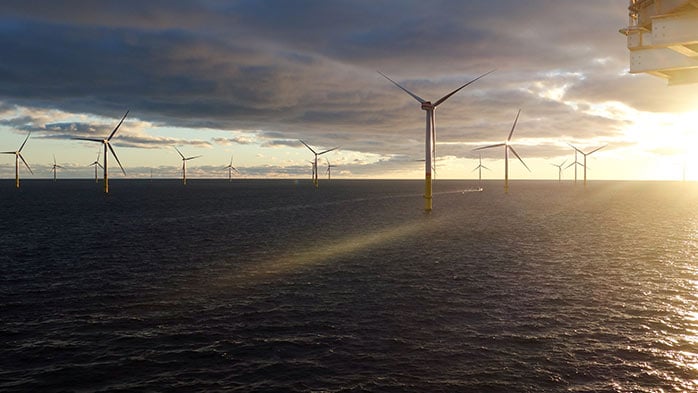Flexible energy demand can ease the challenge of firming renewables, but domestic consumers cannot provide the required flexibility. This can only be provided by large consumers able to operate at low utilisation for multi-day periods, but this has a cost that is often overlooked.
Firming renewables is a big and costly challenge
In a prior Insight, we set out the underlying cost structure of power generation under the UK Low Carbon 2030 plan for electricity supply and identified that power generation costs will rise relative to today, entirely due to renewable (RE) firming requirements, rather than the underlying cost of RE itself.
As in the prior Insight, the costs shown use an optimum solar:wind RE profile for Northern Europe to determine total grid power costs at different RE penetration rates. Costs consider battery storage at 50% daily RE output, to accommodate daily fluctuations in supply, the required level of overbuild to both smooth RE output and minimise supply deficits, as well as the cost uplift associated with fossil power plants operating at increasingly lower capacity utilisations. All analysis is in US dollars.
Costs take account of the capital and operating costs of RE and battery storage, as well as capital and operating costs of fossil power plants. Fossil power plants are assumed to be gas-based, natural gas is priced at $6.5 /GJ and carbon at $20 /tCO2 to reflect pre-energy crisis gas power costs. RE and battery costs broadly reflect expected costs in 2030 in real 2024 terms.
Other generating types, such as nuclear and hydro, are ignored here (i.e. it is assumed they will not play a major role in smoothing variable RE output by operating flexibly – rather, they will operate independently). Thus, the costs shown are those associated with the fossil/RE component of a grid only so the overall cost of power will also depend on the contribution made by nuclear, hydro and other generating types to the final mix.
In this Insight, we take this previous analysis further to include demand management in the future low-carbon grid to understand the degree to which firming costs can be offset by demand-side flexibility (i.e. flexible energy demand).
Demand-side flexibility makes firming easier, but also has a cost
It is often suggested that increased demand management/flexibility is the solution to absorbing variable RE onto a grid and, indeed, costs could be lower if demand flexibility is assumed. In this chart, up to 30% of end demand is allowed to fully flex (i.e. 30% of demand can shift from maximum to zero within a one-hour period and vice versa).
Additionally, gas and carbon prices have been lifted to current levels to show the cost difference relative to the fossil-only power costs today. Here, costs are lower by ~$8 /MWh at ~94% RE penetration after implementing flexible energy demand. However, at lower RE penetration levels, costs are much higher than the non-demand flexibility case.
To give an estimate of the costs of demand flexibility, we have assumed the flexibility is offered by an electrolyser producing green hydrogen. Thus, as an electrolyser operates increasingly flexibly, capacity utilisation and efficiency will fall and unit capital charges and fixed costs will lift. In our model, these added end-use costs are assumed to be compensated for by a lower delivered power price to the flexible user. Non-flexible users are then charged more – by the amount shown in the chart – to ensure the full costs of power production are covered.
A key conclusion here is that demand flexibility is not free – it has a real cost and, in most cases (i.e. up to ~85–90% RE penetration), fossil power flexibility is the more cost-effective option (n.b. at assumed fossil fuel costs). If end-use demand has a greater fixed cost component than an electrolyser, this would result in higher demand management costs than those shown and vice versa.
Given for information, the power generation costs associated with moving to a 100% RE grid are also shown, assuming that firming, over and above demand flexibility, is entirely provided by battery storage, rather than flexible fossil power. Here you can see power generation costs rise to ~$220 /MWh, or ~80% higher than the fossil-only option today.
Domestic users cannot provide the demand flexibility needed
The chart below shows a 500 h slice from within a single year for the 94% RE penetration scenario to demonstrate to the degree to which flexible energy demand needs to respond. This shows there is at least one occasion within this period when demand would be called upon to pull back by up to the maximum 30% for a period of more than 70 hours, or three days. These, and longer, requirements occur several times in the year, alongside multiple smaller, but still multi-day, curtailment events (n.b. full year is not shown).
In our view, this level of flexible energy demand cannot be offered by domestic consumers – typically the focus of demand flexibility efforts – but requires larger, commercial and industrial users to be extremely flexible. However, by necessity, this requires the operation of large industrial equipment at low capacity utilisation levels (n.b. this equates to ‘overbuilding’ those facilities), the need to do so for several days at a time and the ability to rapidly ramp up production when power becomes available.
This mode of operation will not only be costly but also technically and operationally challenging for many sectors. Our view is that the modelled 30% demand flexibility is at the upper end of, or probably beyond, what will be feasible in practice.
Demand flexibility will have a role to play in lowering costs of a decarbonised grid, but the necessary flexibility can only be provided by large commercial or industrial consumers that are able to reduce consumption for multi-day periods. Domestic consumers can only provide intra-day flexibility, but this only accounts for a small proportion of the renewable energy demand and supply imbalances in a RE-heavy grid.
Further, demand flexibility is not cost free and will require large industrial equipment to operate at low capacity utilisations and to be very flexible. Demand flexibility essentially shifts the costs of absorbing RE onto a grid from the grid itself and onto the consumers of power – it does not negate the cost. This will limit the degree to which demand flexibility can be implemented.
If you are thinking about how power costs might impact on your business as countries decarbonise, get in touch, and we will be happy to discuss our work and ideas with you.

















